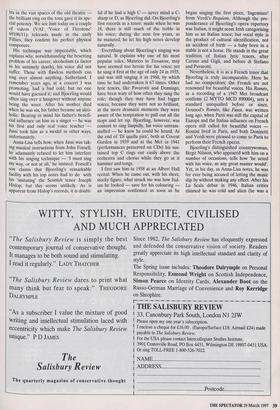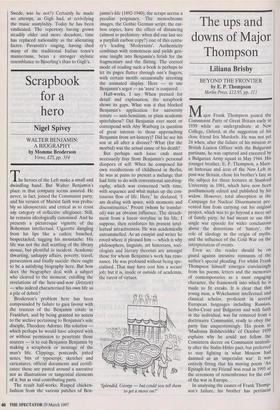Still top of the pops
Michael Scott
JUSSI by Anna-Lise Bjoerling and Andrew Farkas Amadeus, £29.99, pp. 520 Classie FM recently ran a poll among listeners to determine who are Britain's Top Ten favourite opera singers during the last 50 years, with interesting results. Only two are singing nowadays, numbers 3 and 9, Domingo and Terfel (the latter the only one in the early years of his career). The others are either retired (or nearly): 5 Sutherland, 6 Bergonzi, 7 Tebaldi, 8 Corelli and 10 Caballe, or dead like, 4 Gobbi, 2 Callas and 1 Bjoerling.
So formidable today is the influence of recording that singers now not only have to withstand their predecessors' recordings breathing down their necks, but they also have to repeat the same, and by now obviously-dated, repertory. It is indicative that of 'The Three Tenors' only Domingo appears in the Top Ten, although Pavarotti almost does, he is 11th, but Carreras comes nowhere, not even among the Top TwentY.
The reason for the Swede's pre- eminence, although he died in 1960, is not difficult to determine — because his is the most beautiful tenor voice on record. Who says the public can't tell? We would have to go back to the days before recording was hi-fi to find his peers. It is timely therefore that an excellent new English Bjoerling biography has appeared, a translation of her Swedish version by his wife, Anna-Lisa, edited and amplified by Andrew Farkas. . Bjoerling was only 49 at the time of his death, yet his career lasted 40 years. It began at the age of five when he sang Jo concerts with his father and brothers, and it was as a boy that he made his first records. A revealing photograph of the three Bjoer- ling boys singing appears on page 48. No prizes for guessing which is Jussi — he !s standing straight-backed, chest up, his mouth open in the same perfect position as on the back-cover photograph. He says his voice did not break, 'it just gradually dropped from a treble to a tenor.. This accounts for the remarkable quality it always kept. Even in his last season at the Metropolitan, New York, as I remember, less than a year before he died, it was fresh-sounding and responsive. Although not big, it rang out easily above the orches- tra in the vast spaces of the old theatre — the brilliant ring on the tone gave it its spe- cial potency. We see him today on a couple of videos (VAI 'Voice of Firestone' 69106/11): telecasts made in the early Fifties, they confirm his perfect physical composure.
His technique was impeccable, which explains why, notwithstanding the besetting problem of his career, alcoholism (a factor in his untimely death), his voice did not suffer. Those with flawless methods can sing over almost anything. Sutherland, I remember years ago, at a concert I was promoting, had a bad cold, but no one would have guessed it; and Bjoerling would often sing over a hangover without anyone being the wiser. After his mother died when he was six, his father became an alco- holic. Bearing in mind his father's benefi- cial influence on him as a singer — he was his first and only real voice teacher — Jussi took him as a model in other ways, unfortunately.
Anna-Lisa tells how, when Jussi was tak- ing musical instructions from John Forsell, he adamantly refused to let him interfere With his singing technique — 'I must sing my way, or not at all,' he insisted. Forsell's son claims that Bjoerling's remarkable facility with his top notes had to do with his 'imitating' the Scottish tenor Joseph Hislop, but this seems unlikely. As is apparent from Hislop's records, it is doubt- ful if he had a high C — never mind a C- sharp or D, as Bjoerling did. On Bjoerling's first records as a tenor, made when he was 18, there is still much of the treble in his voice; during the next few years, as he matured, he let his high notes develop naturally.
Everything about Bjoerling's singing was natural. It explains why one of his most popular roles, Manrico in Trovatore, may have seemed too heroic for his voice; yet he sang it first at the age of only 24 in 1935, and was still singing it in 1960, by which time he had undertaken it 67 times. Other lyric tenors, like Pavarotti and Domingo, have been wary of how often they sang the role; though they may have had bigger voices, because they were not so brilliant, at the more dramatic moments they were aware of the temptation to pull out all the stops and let rip. Bjoerling, however, was content to sing limpidly, his voice untram- melled — he knew he could be heard. At the end of 'Di quella pira', both at Covent Garden in 1939 and at the Met in 1941 (performances preserved on CDs) his sus- tained top C rings out easily above the orchestra and chorus while they go at it hammer and tongs.
I first saw him in 1958 at an Albert Hall recital. When he came out, with his short, stocky figure, what struck me was how Ital- ian he looked — save for his colouring — an impression confirmed as soon as he began singing the first piece, `Ingemisco' from Verdi's Requiem. Although the pre- ponderance of Bjoerling's opera repertory was Italian, it might seem Irish categorising him as an Italian tenor; but vocal style is the product of cultural identification, not an accident of birth — a baby born in a stable is not a horse. He stands in the great tradition of Italian lyric tenors, after Caruso and Gigli, and before di Stefano and Pavarotti.
Nevertheless, it is as a French tenor that Bjoerling is truly incomparable. Here he had no competitors; the French are not renowned for beautiful voices. His Romeo, as a recording of a 1947 Met broadcast confirms (2 MYTO MCD 890004), sets a standard unequalled before or since. Gounod's Romeo, like Faust, was written long ago, when Paris was still the capital of Europe and the Italian influence on French opera still called for beautiful voices — Rossini lived in Paris, and both Donizetti and Verdi were pleased to come to Paris to perform their French operas.
Bjoerling's distinguished countrywoman, Birgit Nilsson, who appeared with him on a number of occasions, tells how 'he acted with his voice, as any great master would'. Yet, in his day, as Anna-Lisa notes, he was for ever being accused of letting the music slip by without making any effect. After his La Scala debut in 1946, Italian critics claimed he was cold and alien (he was a Swede, was he not?) Certainly he made no attempt, as Gigli had, at revivifying the music unstylishly. Today he has been vindicated. The repertory having grown steadily older and more decadent, time has replaced nationality as the alienating factor. Pavarotti's singing, having shed many of the traditional Italian tenor's mannerisms, bears a stronger stylistic resemblance to Bjoerling's than to Gigli's.




































































 Previous page
Previous page